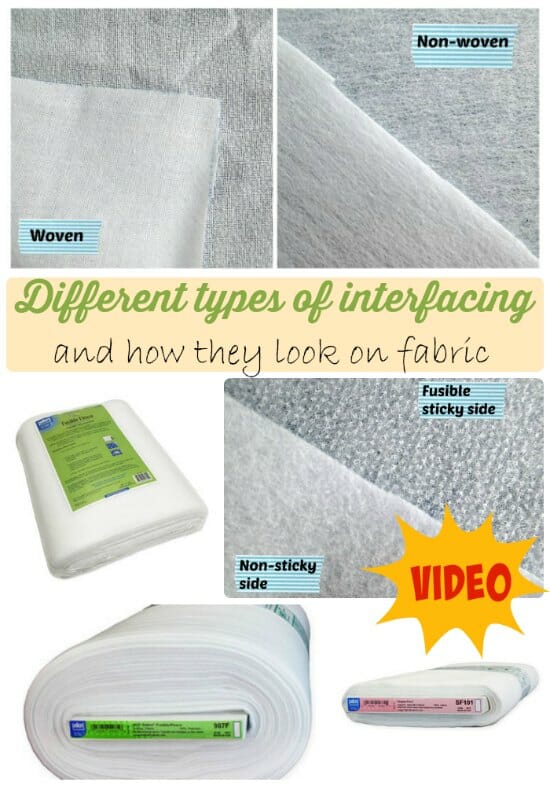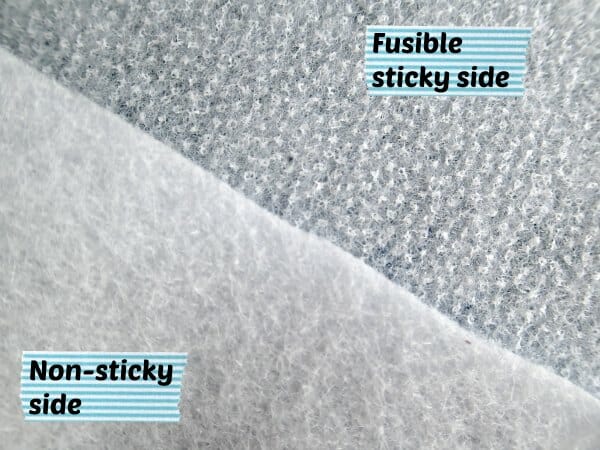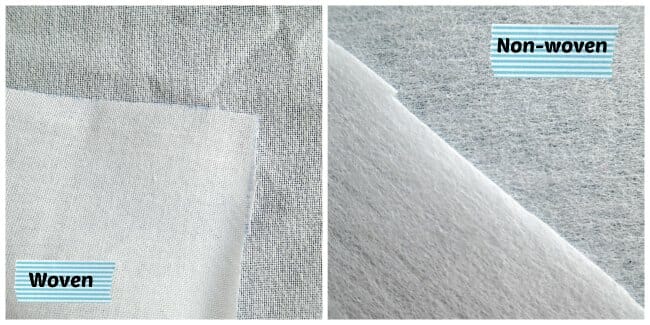
Whether you sew bags or clothes, from time to time, you'll need to use an interfacing on your projects and it can often be difficult to choose which one works best with which project.
Many sewing patterns usually will make a suggestion, but not list an essential interfacing product, because availability varies so widely that what is available in one area or country, can not be found in another area, making a person in that area reluctant to buy a pattern when the stipulated interfacing can't be used.
So let's take a look at a few examples today and you can see in the video how they change the structure of the fabric in each case.
Comparison of different types of interfacing
Subscribe to the YouTube channel:
Fusible versus Sew-in Interfacing


Fusible interfacing has a fabric ‘glue' on one side. You can usually see this quite easily as a shiny glow on the interfacing or feel it as rough tiny dots. Mostly the fusible glue is on the one side, but it can sometimes be on both. Always take care to read the instructions that come with the interfacing as methods can vary, and try not to get the glue on your iron – it makes a nasty mess and can transfer to other projects or your ironing board next time.
Sew-in interfacing can come in many varieties and can have much the same features as the fusible – but without the glue. You'll normally secure the interfacing to the fabric before sewing the project by basting it within the seam allowances, although sometimes you may just layer up the fabric and interfacing and sew together. Check what is called for in the pattern instructions. Ideal when you have a fabric that cannot be ironed or have texture.
Pros and cons – Sew-in interfacing can be a little more tricky to work with because you need to keep an eye on all those layers, but it can give a nicer result on lightweight fabrics because it will still allow them to show their original fabric properties. You may also find the project is less likely to crease with a sew in (although that depends on your fabric). Using a sew-in product also will allow you to trim excess bulk from your seam allowances if the project would benefit from that.
Using fusible interfacing can be easier to keep track of and you simply fuse and then have the one layer to deal with in your sewing = less shifting. Sometimes if you use a sew-in without a fusible, the outside fabric of the project can look loose and floppy even if the bag itself has enough structure. Leaving fusible interfacing still on your seam allowances can give your project a lot of structure to stand up on their own and make the seams stronger – like a frame for the bag. It basically makes your fabric thicker, stronger and easier to work with.
But, sometimes a fusible doesn't work well with your fabric and you can get little creases or stretches when it is cooled. To avoid this, always ‘press' rather than iron your interfacing on, and make sure to leave it to cool completely before lifting it up to use it.
Woven versus Non-woven Interfacing


In a nutshell, woven interfacing is just like fabric – it's woven and has a grain line. Non-Woven interfacing can be used in any direction and is more like a paper.
Woven interfacing – your fabric should still look, feel and move like fabric, albeit a thicker one. Typical woven interfacing may take your quilting-weight cotton up to more the feel of a decor weight fabric. But it still feels like fabric.
You can also get a knit interfacing, called tricot, which can be used on stretch fabrics and may be used to prevent or restrict stretch in areas of the garment to prolong life and shape.
Non-woven interfacing – no grainline, like a felt or fleece. It can range from thin and wispy, through crisp and papery, through to stiff almost like a card, or even lofty like a fleece or foam.
Pros and cons – the woven can be expensive and is typically only available in a much smaller range of weights, properties, and thicknesses. It leaves your fabric feeling and behaving like fabric and usually fuses well without the wrinkles you can sometimes get from a non-woven.
The non-woven is available is a MUCH wider range and is much more affordable, and more easily available. However, it can wrinkle or crease more easily. It can also tear (like paper) and makes the fabric feel less like fabric – which can be a plus depending on your project.
Examples used in the video
- Peltex – ultra-firm
- Decor Bond 809 – crispy
- Shape Flex 101 – woven
- Fuse N Shape – double sided firm
- Deco Fuse 520 – thin but stiff, almost plastic-like, or by the bolt
- Fusible Fleece 987F
- Headliner foam – also similar but more expensive is Annie's Soft and Stable
Other resources:
Pellon Interfacing Guide download from the JoAnn site.
Pellon Crafts and Home Decor interfacing guide








Just wondering if you have a product that you iron on then peel the paper and the back of fabric is waterproof? Used for the bowl covers.
There is a product by Heat&Bond called liquid vinyl, it leaves the fabric looking like oil cloth. Would that help? They also have the type you peel and iron and leaves the fabric with a vinyl finish.
Excellent! I’ve been sewing forever and using interfacings but I’ve learnt a lot watching your video! Thank you!
I am making a memory quilt of my Dads shirts and lightweight knits. Shirts are thin due to wear and i need to know what kind of iron on fusing i can use so it will not make the quilt stiff. Any ideas?
Can you tell me the difference between non woven interfacing and sewing pattern paper? I just ran out of interfacing but have a lot of the sewing pattern paper which seems very similar to non woven interfacing.
Thanks in advance.
I am using fusible interface (one side glue) for the first time and have a lot of difficulties sewing through it. The machine doesn’t stich but it does sew on other materials. What could be the problem?
Clean your needle, check the needle is the right type for the fabric, check that you have threaded the machine correctly, But without a video, it is very hard to know what is going on.
Just saw your question. Did you get what you need? I’ve had that happen, too. If changing needles hasn’t fixed it, my guess is the melted iron-on glue is stopping your needle from going all the way through. If you still have that problem, one thought would be to keep some alcohol or solvent nearby and clean your needle every time it sticks. I’d be interested to know what works best.
Thank you for this detailed instructions regarding interfacings etc. Its always been a daunting exercise to know which one to use for what project. Has given me more info on what to use regarding outfits and bag making etc. Here in Australia we have products lite woven fusible, Birch fusible interfacing non woven, Birch fusible interfacing woven iron on and Birch fusible interfacing multi stretch. We do have Pellon, Vilene and Peltex brands too but I mainly use Birch because its what I can buy locally.
Great video! Quick question. I am about to embark on a t-shirt quilt using tech fabrics – moisture wicking polyester super stretchy. I am not sure what interfacing to use and if the fusible will damage the shirts. Any suggestions?
As a rule, moisture-wicking polyester does not require fusible interfacing but if you use make sure is stretchable fusible interfacing. That said I have to admit I am not familiar with quilting with this type of fabric.
Thank you so very much for this I’m fairly new to sewing and all the different types of interfacing were making my head spin. I’ve bookmarked this because, it’s the best explanation I have found about the different interfacing and what they do, and I know I will need to pop back a few times before I remember all this.
Can a woven interfacing be used for a high waisted pant?
Depends on the fabric, if you do not require stretch there Indeed That is the right interfacing to use.
Question: Where in Canada, Ontario can one find non-woven fusible interfacing for masks?
Thx, Jo
Do you need to pre-wash non-woven fusible interface before using it? I am making face masks and pre-washing my fabrics. I just wanted to make sure I don’t need to worry about that with the interfacing.
No that is not necessary.
I too, use non woven fusible interfacing, and I ALWAYS prewash my material before sewing. I do not prewash my interfacing. I have now made more than 650 masks. No problems.
I need to make a memory bear and needed to buy Pellon p44f fusible interfacing. You can’t find it anywhere. Can you tell me what I can use that would be equal.
What fabric are you using?
is using the “shield” interfacing that is allergen/moisture barrier safe for home made face mask?
Is it safe to use thick interfacing to make a face mask?
yes it is, the important bit is that you can wash it in hot water.
is it safe to use the fusible in masks-
is it safe to use fusible interfacing in face mask?
No, In fact no interfacing is required when doing face masks. Also do NOT use batting. Batting makes the mask unbreathable. 2 layers of 100% cotton is all you need.
what type of interfacing will I use in making a jacket out of real suede?
How think is your suede? It may not need interfacing at all. Having two pieces sewn together is normally enough to keep the shape of a lapel for example. DO send me a picture of what you are trying to do. Remember you only get one chance so better make a muslin first to avoid any disappointment on the fitting.
Very informative. Always struggle with my Interfacings as learning as I go along. Many thanks
Very informative! Even though I’ve been sewing for more than 60 years I did pick up a few tips from your video. Very well done and thank you!
great job! SO informative.
Great info. I’m making an origami fabric wreath and wonder if there’s a batting better than Pelion one side fusible the other feels soft and fleecy. It worked well but wonder if something else would be better.
As far I as know this is the best product, it all depends what look you are going for. You need to explore a bit with a thinker interfacing perhaps and see if that is better for what you have in mind.
Hi there! Thank you for the informative post. I have a question, but I understand if you don’t have time to teach anyone who puts a comment on your blog! Anyway, I am opening up the outseams of a pair of jeans and adding a strip of patchwork. I made the patchwork from a combination of twill, flannel, and corduroy (all of them are fairly lightweight versions of those fabrics.) I’ve never done any quilting before, nor have I ever added a strip to the outseam of pants before, but I feel like I should use interfacing for this project, to support the strips so they ‘ll last longer and not get pulled out of shape. After reading your descriptions, I’m thinking either sewn-in, or a woven fusible would work best. Do you have any advice?
Thanks!
Woven fusible interfacing will give your patchwork many more years of life.
Thank you very much for your time and advice! I will use the woven fusible!
Hi Jenifer, both will work, it all depends what you have at hand and what look you are going for. Of the two of them sewn will last longer if you sew a few line to keep it in shape and attached to the strip. A picture always helps to know what you are going for, do not hesitate to send me an email. mayra@so-sew-easy.com
This is wonderful. Thanks for posting. I look at bolts of interfacing and get mind boggled. You explained interfacing so well.
The Pellon Interfacing guide on JoAnn website is no good.
Wonderful tutorial! I still have yet to use an interface, but this certainly makes me more courageous!
I am making a coat and using a fusible interfacing on front, back and collar pieces. The problem is it seems very stiff and I don’t intend washing this garment once its made up. Any suggestions to get the interfacing to relax?
Hi Carol, it all depend on the design of the coat and the fabric you are using. Without this info is hard to tell you what to use. Those areas you mentioned are supposed to roll and have a crisp look giving the elegant look of most coats. You could use a softer, Sew in interfacing. But be careful not to compromise the quality of the finished product.
I am working on a quilt for a friend who gave me all of the material & interfacing. However I have never seen interfacing like this before. I did cut a small piece and tried to fuse it and it did work. It is not woven, but almost like paper on the one side and a thin plastic almost on the other. It does separate too. Can you enlighten me? There was not a label, directions etc.
What you got there is called wonder under I believe, it is used to make appliques, have a look at this post where I use a similar product and let me know if that is what you got.
I am a uniform manufacturer for Hotels in Dubai U.A.E. I am facing problems with the collar fusing as it becomes bubbly in few washes. Can you recommend a proper fusing interface material and company so i could import the same. Thank you.
No sorry you need contact sellers in China.
The best explanation and demonstration I have seen on the web. Thorough and even-handed. Thank You!
What a great video – so very organized and informative. Appreciate all your work.
Fantastic turorial. I have muddled through with what I could get at the local shop [which is closing in 2 months] never though to get something on the internet and now I know what I should be getting for which project. THANK YOU
This was such a helpful post, thank you! I have so many of your posts printed or bookmarked. I wanted to add that I recently took a class on http://www.patternreview.com that focused exclusively on interfacing that came with a kit with samples of 24 different types of interfacing taught by Sarah Veblen. The class was a bit pricier than the Craftsy one (which I’m also enrolled in) but way more in depth and the kit alone made it worth the cost. I think it was initially priced around $100 (including the kit and shipping) but I bought it at a sale price shortly before the class ran and it came to $65 and I definitely think it was worth it, especially for the kit. It is a scheduled class but I believe PR offers it periodically. I would definitely recommend it for anyone who is interested in using interfacing to step up garment making. I don’t get anything for recommending this, just wanted to share something I felt was definitely worth the money.
I cannot tell you how much I love your projects and information. This video has given me the exact information I need for making the hat that I have been wanting for so long. I now can purchase the appropriate interfacing without my usual “trial and error” way of doing things. Thank you so much!
Good information about interfacings!! I’ve got a Craft Gossip post that links to your post here:
http://sewing.craftgossip.com/types-of-interfacing-and-how-to-choose-the-right-one-for-your-project/2015/02/22/
–Anne
Thanks so much Anne, I appreciate the share.
I love reading your newsletters, its become a Sunday habit. I work at a local shop in the US and also teach, your video on interfacing was awesome. I have a sample swatch set up I take with me when teaching, but I loved the idea of headliner, I have used my leftover fleece, but I would never have thought about using the headliner to make a quilted fabric. Thanks for all you do.
Ginger
Thanks so much Ginger, that’s really kind of you. I always struggle to know what types of interfacing to recommend because I usually stick to just the couple I can get here locally, so this was as much a learning experience for me too!
I needed that. Too many different kinds to know what too choose, so this helps. Thanks for all of your hard work.
As usual you did a great job covering this subject. The video was well done and helped me to know which interfacings to choose especially for working with bags. I really appreciated seeing the draping qualities of each one. Thank you as always.